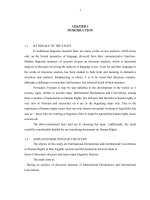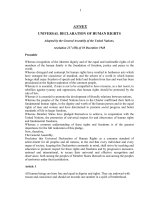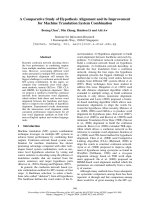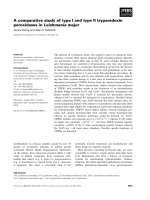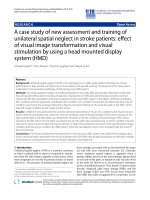UNDERSTANDING INTERPROFESSIONAL EDUCATION: A MULTIPLE-CASE STUDY OF STUDENTS, FACULTY, AND ADMINISTRATORS
Bạn đang xem bản rút gọn của tài liệu. Xem và tải ngay bản đầy đủ của tài liệu tại đây (1.44 MB, 165 trang )
UNDERSTANDING INTERPROFESSIONAL EDUCATION:
A MULTIPLE-CASE STUDY OF
STUDENTS, FACULTY, AND ADMINISTRATORS
Katherine Henkin
Submitted to the faculty of the University Graduate School
in partial fulfillment of the requirements
for the degree
Doctor of Philosophy
in the Department of Anatomy and Cell Biology,
Indiana University
July 2013
ii
Accepted by the Faculty of Indiana University, in partial
fulfillment of the requirements for the degree of Doctor of Philosophy.
_______________________________
Robert J. Helfenbein, Ph.D., Chair
_______________________________!
Patricia R. Ebright, Ph.D., RN, FAAN
_______________________________!
Doctoral Committee Ronald L. Shew, Ph.D.
_______________________________
May 28, 2013 Laura J. Torbeck, Ph.D.
_______________________________
Lee G. Wilbur, M.D.
iii
ACKNOWLEDGEMENTS
Many have guided me, professionally and personally, throughout this dissertation
journey. My deepest gratitude goes to my dissertation committee, the research
participants, and my family.
My dissertation chair, Dr. Robert Helfenbein, continuously challenged me and
remained my steadfast advocate. His expertise and encouragement, even during times of
self-doubt, made this process manageable. I extend my sincere thanks to Rob for his
professionalism and for believing in this research and, importantly, believing in me.
I also thank Dr. Pat Ebright, Dr. Ron Shew, Dr. Laura Torbeck, and Dr. Lee
Wilbur. They encouraged and challenged me to think more deeply and offered a fresh
perspective. Their contributions were important to this research and its completion.
This study would not have been possible without the research participants from
the Indiana University School of Medicine and the Indiana University School of Nursing.
Their openness, honesty, experiences, and willingness to participate made this research
meaningful and enjoyable.
Finally, I give sincere and deep thanks to my family. My parents, Ann and Joe;
brother, Joe; sister, Helen; brother-in-law, Jeff; and my fiancé, Noah, believed in me and
this research. Despite our distances from each other, their undying support was exactly
what I needed to persevere and complete this chapter of my life. Their words of cheer and
encouragement kept me grounded, recalibrated me during the toughest moments, and
reminded me that I could and would achieve this goal. Thank you so much.
iv
ABSTRACT
Katherine Henkin
UNDERSTANDING INTERPROFESSIONAL EDUCATION:
A MULTIPLE-CASE STUDY OF
STUDENTS, FACULTY, AND ADMINISTRATORS
Although interprofessional education (IPE) opportunities can help prepare
students for future practice and patient-centered care, many health professions students in
the country are not educated in an environment with opportunities to learn with, from, or
about students from other health professions. With upcoming curricular changes at the
Indiana University School of Medicine (IUSM) and the Indiana University School of
Nursing (IUSN), IPE remains at the forefront of these changes in both schools. To date,
few studies have explored student, faculty, and administrators’ conceptualizations of IPE
prior to formal implementation. Additionally, previous studies have not compared IPE
conceptualizations across these groups. This multiple-case study explores and compares
how groups of stakeholders from the IUSM (Indianapolis) and the IUSN (Indianapolis)
conceptualize IPE. Data collection included the examination of discipline-specific public
documents and one-on-one interviews (N=25) with pre-licensure students, clinical
faculty, and administrators from each school. Coding and extraction of themes transpired
through within-case and cross-case analysis and data supported the following findings:
the ‘business of medicine’ may prevent IPE from becoming a priority in education;
stakeholders’ conceptualizations of IPE are shaped through powerful experiences in
education and practice; students desire more IPE opportunities at the institution;
v
stakeholders at the IUSN have a long-standing investment in IPE; and the institution
requires a ‘culture shift’ in order to sustain IPE efforts. The findings suggest that IPE
belongs in all education sectors and IPE efforts deserve reward and reimbursement. The
findings also insinuate that leadership, roles, and team training education belong in IPE
and IPE culture requires all individuals’ (e.g., student, faculty, administrators, patients)
commitment. Importantly, the institution must continue IPE development, research, and
dissemination. These findings can help shape curricula as time progresses, increase the
likelihood of developing a successful new curriculum, and prompt ongoing reflection
about IPE. This information can influence how institutions approach IPE and may lead to
a more successful and informed IPE curriculum in the first years of implementation. And,
hopefully what is learned through IPE will be translated into healthcare practice
environments.
Robert J. Helfenbein, Ph.D., Chair
vi
TABLE OF CONTENTS
List of Figures x
List of Abbreviations xi
Chapter 1: Introduction 1
Background and Problem Statement 1
Study Purpose and Central Questions 6
Study Significance 7
Definitions and Key Terms 8
Organization of Dissertation 9
Chapter 2: Literature Review 10
Theoretical Framework and Learning Theory 10
History, Development, and Trends in IPE 13
Understanding of IPE in the Health Fields 20
Faculty and administrators’ understanding of IPE 20
Students’ understanding of IPE 24
Summary of the Literature Review 28
Chapter 3: Method 30
Study Design 30
Positionality and Researcher Stance 31
Recruitment and Sampling 33
Participants 35
Students 35
Clinical faculty and administrators 36
vii
Setting 37
Indiana University School of Medicine 37
Indiana University School of Nursing 38
Data Collection 39
Document analysis 40
Interviews 40
Data Organization and Analysis 41
Ethics 43
Trustworthiness 43
Limitations 46
Chapter 4: Findings 47
General Contextual Background at IU 47
Indiana University School of Medicine 47
Indiana University School of Nursing 48
Current state of IPE at IU 48
Themes 49
Theme one: The business of medicine 49
A double-edged sword 50
That is how it has always been 52
Theme summary 57
Theme two: The power of experience 58
Two heads are better than one 59
Woven experiences 62
viii
Light bulb moments 68
Experience is the best teacher 72
Theme summary 79
Theme three: Desire for IPE 79
Theme summary 84
Theme four: Enthusiasm, hope, and investment in IPE 84
Nursing ‘champions’ 84
IPE as the norm 87
Legitimate partners 88
Theme summary 90
Theme five: Culture shift 90
Let our sacred cows die 90
Leaping forward 92
Theme summary 95
Chapter Summary 96
Chapter 5: Discussion 97
Revisiting the Framework 97
Revisiting the Themes 98
The business of medicine 98
The power of experience 105
Desire for IPE 108
Enthusiasm, hope, and investment in IPE 112
Culture shift 114
ix
Suggestions for Future Research 117
Conclusion 119
Figures 121
Figure 1. Interprofessional education for collaborative patient-centred
practice: An evolving framework. 121
Figure 2. Primary and embedded cases. 122
Figure 3. Steps in data analysis. 123
Figure 4. Phases of data analysis. 124
Appendices 125
Appendix A: Study Information Sheet 125
Appendix B: IPE Recruitment Email 127
Appendix C: Research Matrix 128
Appendix D: IPE Interview Protocol 129
Appendix E: Composite Graphic for Themes 131
References 134
Curriculum Vitae
x
LIST OF FIGURES
Figure 1. Interprofessional education for collaborative patient-centred
practice: An evolving framework. 121
Figure 2. Primary and embedded cases. 122
Figure 3. Steps in data analysis. 123
Figure 4. Phases of data analysis. 124
xi
LIST OF ABBREVIATIONS
IOM: Institute of Medicine
IPE: Interprofessional Education
IPP: Interprofessional Practice
IU: Indiana University
IUSM: Indiana University School of Medicine
IUSN: Indiana University School of Nursing
WHO: World Health Organization
1
Chapter 1: Introduction
Background and Problem Statement
With the growing complexity of the healthcare system and patient care, it is
essential that professionals from all types of healthcare fields join forces and work
interprofessionally (Josiah Macy Jr. Foundation, 2010). Working interprofessionally
involves working alongside others from different professions and collaborating with
individuals of different skill sets to make shared, informed decisions. This can pose
challenges for health professionals because interprofessional collaboration may not be
taught in educational institutions (IOM, 2003) and the way health professionals practice
tends to be a direct reflection of how they were educated (Wakefield, Cooke, & Boggis,
2003).
Unfortunately, discrepancy exists between health professions education and
professional practice; education in the health professions has not paralleled changes that
have transpired in practice (Interprofessional Education Collaborative Expert Panel,
2011; Josiah Macy Jr. Foundation, 2010). Beyond the educational arena, it is often
assumed and expected that professionals know how to effectively communicate and
collaborate in healthcare teams. However, in the United States, most undergraduate
health professions schools do not provide opportunities in their curriculum for students to
communicate with students from other professions, let alone collaborate or make
decisions with students from other professions. Although debate exists about when to
introduce interprofessional education (IPE) into curriculum, many scholars maintain that
health professions students (e.g., students in medicine, nursing, physical therapy,
pharmacy, occupational therapy, dentistry) should begin working together early in their
2
undergraduate health professions education in order to better prepare them for future
practice and interprofessional decision-making (Leaviss, 2000; McPherson, Headrick &
Moss, 2001; Tunstall-Pedoe, Rink, & Hilton, 2003; Wakefield et al., 2003). The lack of
interprofessional opportunities in health professions education can be problematic and
may make the transition from health professions student to healthcare professional one
that is amass with struggles.
Although most health professions students are not educated interprofessionally,
one of the most reassuring aspects of this reality is that healthcare education is, indeed,
attempting to accommodate for changes seen in practice (Interprofessional Education
Collaborative Expert Panel, 2011). With proactive efforts in curricular reform, IPE has
been placed on the curricular map and a widely recognized definition has been
established. The World Health Organization (WHO) offers the following:
“Interprofessional education occurs when students from two or more professions learn
about, from and with each other to enable effective collaboration and improve health
outcomes” (2010, p. 7). Interprofessional education prepares students in the health
professions for a more effective future interprofessional practice (Le, Spencer, & Whelan,
2008). The goal of IPE is threefold: for students to learn skills, knowledge, and attitudes;
for students to carry these attributes into practice to promote more effective collaboration;
and to improve the safety and quality of patient care (Reeves, 2009).
An inaugural objective of IPE was to decrease strained relationships of healthcare
professionals that ultimately impair patient care and outcomes (Anderson, Thorpe, &
Hammick, 2011; Ryan & McKenna, 1994). Although IPE can span all healthcare
professions, the fields of nursing and medicine hold a distinct place in the IPE landscape.
3
Physicians and nurses remain two of the chief components of the healthcare team, and
collaboration among these professionals is necessary (Nadolski et al., 2006). Not only do
nurses and physicians work very closely with one another and have a unique relationship
(Stein, 1968; Sweet & Norman, 1995), they also make up the largest proportion of
healthcare providers (as cited in Manojlovich & DeCicco, 2007). Despite the inevitable
interactions of nurses and physicians in the workplace, traditional medical and nursing
school educational curricula do not provide opportunities to develop or nurture this
unique and close relationship. Larson (1999) argued that a malfunctioning
interprofessional relationship between a nurse and physician can be harmful to patients
and is not only unfavorable, but also unethical.
A functioning interprofessional relationship can stem from IPE. Interprofessional
education can reduce hierarchies, break down misperceptions, construct professional
identities, and highlight what others can offer to the team (Olenick, Ryan Allen, &
Smego, 2010). What is learned through IPE can translate to practice, and it is largely
recognized that the landscape of nurse-physician collaboration is one that can affect the
outcomes for, not only nurses and physicians, but also for patients and healthcare
organizations (Larson, 1999; Patronis Jones, 1994). Interprofessional collaboration is
linked to improved patient outcomes (Baggs et al., 1999; Boyle & Kochinda, 2004;
Henneman, Dracup, Ganz, Molayeme, & Cooper, 2001; Schmalenberg et al., 2005),
decreased healthcare costs, decreased patient length of stay, decreased patient mortality,
increased nurse autonomy, nurse job satisfaction (Rosenstein, 2002), and increased nurse
perceptions of high-quality care (Schmalenberg et al., 2005). While the advantages of an
IPE curriculum are clear, challenges exist. The literature notes that the major issues in
4
IPE relate to scheduling (Blue, Zoller, Stratton, Elam, & Gilbert, 2010) and “rigid
curriculum, turf battles and lack of perceived value” (Curran, Deacon, & Fleet, 2005, p.
76), but perhaps the most significant challenges of implementing an IPE curriculum are
attitudinal (Anderson et al., 2011; Gilbert, 2005). Nurses and physicians have a long
history of occasional discord in their professional environments; therefore educating
nursing and medical students, faculty, and administrators about the underpinnings of IPE
and assuring them of its value may be the biggest challenge to overcome (Gilbert, 2005).
In addition, several factors play a critical role in successful IPE implementation. These
factors include administrator and faculty support, collaboration with other health
professions programs, an IPE curriculum team, faculty compensation and
acknowledgement for participating in IPE, and assessment tools for IPE evaluation
(Buring et al., 2009). Another key challenge relates to the time and effort required to
establish evaluation and measurement tools for IPE (Illingworth & Chelvanayagam,
2007). Despite these challenges, many argue IPE should no longer be considered the
ideal in health professions education, but rather a realistic, practical, and achievable way
to establish trust and collaboration among professionals (Gilbert, 2005; McPherson et al.,
2001; WHO, 2010).
Along with the growing recognition of the benefits and challenges of IPE and
shifts in curricula, some organizations and accrediting bodies encourage or require health
professions schools to include interprofessional opportunities in their curricula. Both
national and international organizations such as the Institute of Medicine (IOM) and the
WHO have championed efforts to include IPE in healthcare education (IOM, 2001; IOM,
2003; WHO, 1988; WHO, 2010). In addition, organizations from individual health
5
professions, such as the Association for American Medical Colleges (AAMC, 2011) and
the American Association of Colleges of Nursing (AACN, 2008) stand behind IPE.
Despite IPE’s position at the forefront of national and international healthcare
education dialogue, health professions students are still predominantly educated
separately (e.g., nursing students are taught in isolation from medical students)
(Barnsteiner et al., 2007; Buring et al., 2009; Fagin, 1992; Heuer, Geisler, Kamienski,
Langevin, O’Sullivan Maillet, 2010; Margalit et al., 2009; Oandasan & Reeves, 2005b;
Rafter et al., 2006; Sargeant, 2009; Walrath et al., 2006) and little is taught about how
health professionals can and should work together effectively (Josiah Macy Jr.
Foundation, 2010). Over the last 30 years, IPE has gained momentum, but
implementation has been slow and few schools have a formal IPE curriculum (Thompson
& Tilden, 2009; Blue, Zoller, Stratton, Elam, & Gilbert, 2010) or a commitment to IPE
(Bennett, 2011).
Although an IPE curriculum may help prepare undergraduate health professions
students for patient-centered collaborative practice (WHO, 2010), implementation
remains complex and takes careful and strategic planning (Davenport, Spath, & Blauvelt,
2009; Oandasan & Reeves, 2005b). Implementation of IPE requires “joint responsibility
across a number of jurisdictions…” (Gilbert, 2005, p. 32) and students, faculty, and
administrators can be major powerhouses or stakeholders during curricular development
and reform (Bland et al., 2000). Students,’ faculty, and administrators’ understanding of
the concept of IPE can influence not only the way students are educated but also the
development and improvement of curriculum and the way healthcare is practiced. Their
input in the curricular process is essential.
6
The Indiana University School of Medicine (IUSM) and the Indiana University
School of Nursing (IUSN) are actively engaged in curricular reform and continue to
collaborate on the implementation of IPE curricula. However, at this stage, IPE is not
fully integrated across the educational culture at these schools and little formal IPE
curriculum exists that includes collaboration between students at the IUSM (Indianapolis)
and the IUSN (Indianapolis). At this pre-IPE implementation phase of curricular reform,
students,’ faculty, and administrators’ understanding of IPE are important to guide
Indiana University’s (IU) IPE curricular efforts. Whether these stakeholders’ perceptions
are shared or not can influence the organization (Malloy et al., 2009) and the
implementation of IPE at IU. One way to measure the impact of IPE is to look at changes
in attitudes and perceptions (Oandasan & Reeves, 2005b); however, these changes cannot
be detected without first knowing stakeholders’ baseline understanding of IPE. In the
future, stakeholders’ baseline understanding of IPE can help measure ongoing, and
perhaps evolving changes in perceptions and, ultimately, the impact of IPE curricula.
Study Purpose and Central Questions
The purpose of this multiple-case study is twofold. First, the researcher explored
and described how groups of students, faculty, and administrators at the IUSM
(Indianapolis) and the IUSN (Indianapolis) understand the concept of IPE. This research
occurs at a crossroads in health professions education—curricular reform is transpiring,
but little formal IPE curriculum involving both schools exists; hence the participants’
understanding of IPE was elicited prior to implementation of a formal IPE curriculum
involving both schools. Second, the researcher compared participants’ understanding of
IPE within and across the groups. For this research, IPE is defined as “when students
7
from two or more professions learn about, from and with each other to enable effective
collaboration and improve health outcomes” (WHO, 2010, p. 7).
The following research question guides this study:
How do students, faculty, and administrators at the IUSM (Indianapolis) and IUSN
(Indianapolis) conceptualize and understand IPE?
In addition, the following sub-questions help direct this study:
a. How do these individuals define and describe IPE?
b. How are these groups’ understandings of IPE shaped?
c. How do the groups’ perspectives of IPE differ or align?
Study Significance
This research is significant, especially at IU, because the nursing and medical
schools are in the midst of curricular reform. Stakeholders (students, faculty, and
administrators) hold a place of power in curricular reform and their perceptions can help
drive and guide curricular changes. Discovering how stakeholders understand IPE can
mold and craft curricula as time progresses, increase the likelihood of developing a
successful new curriculum, and prompt ongoing conversations, thought, and reflection
about IPE. If stakeholders’ background knowledge and perceptions of IPE are known, a
premise for IPE can be established and educational institutions such as IU can build upon
this foundation. This information can influence how institutions approach health
professions education and can apply to IPE initiatives at other IU campuses. In turn, this
may lead to a more successful and informed IPE curriculum in the first years of
implementation. And, hopefully what is learned through IPE will be translated into
healthcare practice environments.
8
Definitions and Key Terms
Many different definitions and interpretations of IPE exist in the literature
(Olenick et al., 2010). This research employs the WHO’s nationally and internationally
accepted definition of IPE: “Interprofessional education occurs when students from two
or more professions learn about, from and with each other to enable effective
collaboration and improve health outcomes” (WHO, 2010, p. 7). Beyond the definition,
Olenick et al. (2010) indicated that IPE includes certain attributes such as interactional
learning experiences that are experiential, sharing of knowledge and principles, a patient-
centered philosophy, and a “nonhierarchical” attitude (p. 77).
In addition to defining and describing IPE, it is also important to elucidate what
IPE is not. Interprofessional education is not a passive pedagogy. It does not involve
students seated in a lecture hall together without interacting, nor is it a faculty member
from another profession talking to a group of learners without incorporating an
interactive piece (Buring et al., 2009). Moreover, interprofessional does not equal
‘multidisciplinary’ or ‘interdisciplinary’ because these terms do not highlight the sharing
process between and across disciplines that must be present with IPE. MacIntosh and
McCormack (2001) clarified the difference between the prefixes multi- and
inter-; ‘multi-’ refers to partners working individually toward a goal whereas ‘inter-’
infers that partners from different disciplines work together towards a shared goal. One
can think of the concept as an orchestra. Interprofessional education is not the sum of
each individual’s contribution to the process, but rather each member of the orchestra (or
team) is an integral part of the whole, and everyone must work together to produce a
masterful overture (as cited in Olenick et al., 2009).
9
Organization of Dissertation
Chapter 2 describes the theoretical framework used to guide this research, a more
in-depth history of IPE, and literature that focuses on IPE perceptions, attitudes, and
experiences. Following the literature review, Chapter 3 outlines the methods for this
study. Chapter 4 presents the findings from interviews with students, clinical faculty, and
administrators. Finally, Chapter 5 analyzes the findings, offers implications of the study,
and presents suggestions for future research.
10
Chapter 2: Literature Review
This research explores and compares how students, faculty, and administrators
from the IUSM (Indianapolis) and the IUSN (Indianapolis) understand IPE. In this
review, the researcher outlines the theories and literature guiding this study. First, this
chapter provides the theoretical framework that serves as a sound backdrop for the
research. Second, the researcher revisits the history, development, and trends in IPE to
give a background perspective of IPE and its progression through the years. Finally, this
review recapitulates and critiques the pertinent literature on faculty, administrators,’ and
students’ attitudes, experiences, and perceptions of IPE because these studies help inform
the research questions and provide the groundwork for this study.
Theoretical Framework and Learning Theory
Early publications within the field of IPE are largely atheoretical (Clark, 2006);
however, within the last decade, theories and frameworks have surfaced in IPE literature
(Hean et al., 2009). When developing IPE curricula and theories that relate to curriculum
development, the individual, the organization and institution, and the socio-cultural and
political levels are important considerations (Oandasan & Reeves, 2005b). D’Amour and
Oandasan (2005) developed a framework that not only captures these elements, but also
stresses the relationships between each one of them. This theoretical framework focuses
on the recently developed concept of interprofessionality and serves as the theoretical
framework for this study. In addition to the aforementioned theoretical framework, this
study uses social constructivism and socio-cultural learning to guide the understanding of
how participants learn and build knowledge from their surrounding environment.
11
As a result of research completed for Health Canada (Oandasan et al., 2004),
D’Amour and Oandasan (2004; 2005) developed an emerging framework in the field of
IPE called “Interprofessional Education for Collaborative Patient-centred Practice: An
Evolving Framework” that highlights the concept of interprofessionality. Not only is
interprofessionality a new concept in the field of IPE, it is also the first term and notion
that explicitly emphasizes the interconnectedness of IPE and interprofessional practice
(IPP) and the factors that influence them. For the purposes of this study, the researcher
embraces D’Amour and Oandasan’s definition of interprofessionality that states,
“Interprofessionality concerns the processes and determinants that influence
interprofessional education initiatives as well as determinants and processes inherent to
interprofessional collaboration. Interprofessionality also involves analysis of the linkages
between these two spheres of activity” (2005, p. 8).
In this framework there are two interrelated concepts represented by circles, one
for IPE, which this research focuses on, and the other for interprofessional collaborative
practice (see Figure 1). In the IPE circle, the learner and educators reside at the center and
are reciprocally connected via bi-directional arrows. The key element to the IPE circle is
that the bi-directional arrows portray that learners’ and educators’ understanding of IPE
and IPP is shared, formulated, and refined through learner-educator interactions
(D’Amour & Oandasan, 2005). The learners and educators are also connected to micro,
meso, and macro factors that impact the learner’s capability to provide collaborative
patient-centered practice. The micro (teaching) factor focuses on the context of the
learning environment, how collaboration is taught, faculty development in IPE, and
faculty perceptions about collaboration. The meso (institutional) factor includes
12
leadership and administrative processes influential in accelerating IPE efforts. The macro
(systemic) factor includes the larger bodies that influence the meso and micro factors
such as accreditation and regulatory bodies, the institution, and federal and state
government legislature and policy (D’Amour & Oandasan, 2005). Research and
evaluation are positioned at the foundation of this framework. Arrows connecting
research to the IPE and interprofessional collaborative practice circles illustrate the
feedback nature of the framework and that not only does research guide IPE and
interprofessional collaborative practice, but IPE and interprofessional collaborative
practice inform research. In summary, this framework is important for this research
because it specifies that learners, educators, and administration are critical elements of
interprofessionality and are strongly interconnected and influential in the development
and implementation of IPE (D’Amour & Oandasan, 2005). These specifics are the
impetus behind including students, faculty, and administrators in this research.
In addition to the framework on interprofessionality, social constructivism is
often a theory linked to curriculum development and IPE (Hean et al., 2009). This theory
serves as a guide for understanding the process of learning through an individual’s
interactions with the environment (Hean et al., 2012). Although social constructivism
remains relevant and applicable to IPE, some argue that it only focuses on the individual
(micro) level rather than focusing on the system and socio-cultural (macro) level (Hean et
al., 2009). However, socio-cultural learning, a branch of social constructivism, transcends
the individual and emphasizes the social and organizational aspects of IPE (Hean et al.,
2009). In socio-cultural learning, Vygotsky (1978) introduced the following concept of
the zone of proximal development (ZPD): “The ZPD is the difference between what a
13
student can learn alone and what they can learn with the assistance of an external other”
such as the organization or community, a student from another profession, or an IPE
facilitator (Hean et al., 2009, p. 256). This notion closely relates to the idea of
scaffolding, where students build on previous knowledge and complete more complex
tasks with the help of others in the environment (D’Eon, 2005). Once knowledge and
skills are acquired, the ‘scaffolding’ can be removed and the learner becomes more
independent (Lewis, 2011). Social constructivism and socio-cultural learning is reflected
in the definition of IPE. The idea that IPE requires students to learn about, from, and with
each other (WHO, 2010) necessitates that the learner interact with other learners and the
environment (Hean et al., 2009). This theory asserts that participants’ understanding of
IPE is important to describe because it provides the initial ‘scaffolding’ of which learners
can build upon as they progress through an IPE curriculum. In addition, social
constructivism stresses that interactions with the environment and surrounding people
help construct reality; these interactions are the basis of IPE.
History, Development, and Trends in IPE
Much of the current IPE literature is descriptive and narrative, however it
contributes to the understanding of the origins and development of IPE. With the
progression of time, IPE has grown, and the literature is a testament to how IPE began,
how it has evolved, and what the future holds.
Although IPE remains a trendy topic in today’s healthcare education, it is not a
new initiative (Bennett, 2011). Several countries, including Canada, Australia, Nordic
countries, and the United Kingdom (UK), have been trailblazers in IPE (Wilhelmsson,
Ponzer, Dahlgren, Timpka, & Faresjo, 2011). Interprofessional education stemmed from
14
concerns about care quality, patient safety (Olenick et al., 2010), and strained
relationships between healthcare providers (Anderson et al., 2011; Ryan & McKenna,
1994). One of the earliest references of collaboration in the health fields can be traced to
the 1940’s when the U.S. was in the midst of war (Baldwin, 1996). At that time,
collaboration was based on a need, the urgency to work together to deliver care at home
and on the warfront. This period marked the beginning of a broader delivery of care and
education. Other early accounts of IPE occurred during the 1960’s in the UK (Barr, 2010;
Le et al., 2008), where greater emphasis was placed on primary care practice and
teamwork among health professionals.
Throughout the 1960’s, the nurse-physician relationship was at the forefront of
healthcare dialogue. In a historical narrative piece, Stein (1967) described how the nurse-
physician relationship could be equated to a game. Stein described this ‘game’ as
equilibrium between nurses and physicians. The nurse gave care suggestions to the
physician without sounding like she was making a recommendation, and the physician
asked for care suggestions from the nurse without blatantly stating this. If the rules of the
game were not abided by, unsatisfactory care ensued. During this time, the hierarchy in
healthcare was palpable (Patronis Jones, 1994) and in an effort to reduce the tensions
associated with the nurse-physician relationship, two organizations, the American Nurses
Association and the American Medical Association, formed the National Joint Practice
Commission (Fagin, 1992). However, after 10 years of working together to improve the
nurse/physician dynamic, an increase in the nurses’ roles and compensation caused the
American Medical Association to back out of the National Joint Practice Commission
(Fagin, 1992).


